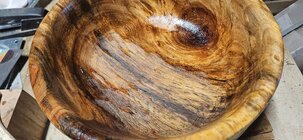I have had this same problem with water-based spray polyurethane, and now with oil-based polyurethane in a quart sized can. I get a nice glossy finish, but with a spot that just seems to suck in whatever I put on it and still end up dull. This bowl is an example of that. The whole outside looks good, and much of the inside, except for that "dry" spot. It's a piece of pecan, spalted, but not punky.
I've read that this is caused by not mixing the polyurethane enough, but for the same area to show up dry after several coats, I'm thinking there's another issue. I had assumed that the first coat would seal the wood and stop it from absorbing more of the finish, so that the second coat would be uniform. Nope. Not the third, or the fourth either.
Obviously, finishing chemistry and technique is not my strong suit. I was simply applying Minwax pastewax to my pieces, but I wanted a little more shine. I've used polyurethane for other projects in the past, and I've never seen this before.
Help?

I've read that this is caused by not mixing the polyurethane enough, but for the same area to show up dry after several coats, I'm thinking there's another issue. I had assumed that the first coat would seal the wood and stop it from absorbing more of the finish, so that the second coat would be uniform. Nope. Not the third, or the fourth either.
Obviously, finishing chemistry and technique is not my strong suit. I was simply applying Minwax pastewax to my pieces, but I wanted a little more shine. I've used polyurethane for other projects in the past, and I've never seen this before.
Help?

